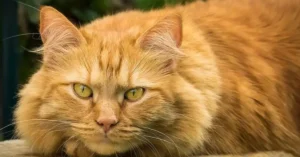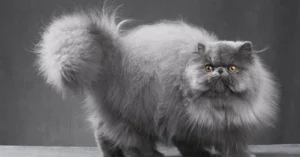Cats, with their enigmatic behaviors and captivating personalities, have long been cherished companions. Among the numerous feline breeds, the British Shorthair stands out for its distinctive characteristics. In this comprehensive guide, we will explore the world of British Shorthairs and decode their unique behaviors, shedding light on their quirks and challenges.
Table of Contents
ToggleUnderstanding the Unique Traits of British Shorthairs Cat
The Allure of British Shorthairs
The British Shorthair cat’s appeal is undeniable. From their round faces and stocky bodies to their dense, plush fur, these cats exude charm. Let’s delve into the fascination that surrounds them.
- Distinctive Appearance: Describe their physical features.
- History and Heritage: A brief overview of their lineage.
The Nature vs. Nurture Debate
Are a cat’s behaviors predetermined by genetics, or can they be shaped by their environment? British Shorthairs possess certain genetic traits that influence their behaviors.
- Genetic Predispositions: Discuss common genetic factors.
- Personality Traits: Explore their typical behaviors.
Common Personality Traits
British Shorthairs have unique personality traits that set them apart. It’s crucial to understand these traits to interpret their behaviors accurately.
- Independence: Highlight their independent nature.
- Adaptability: Discuss how they adapt to different settings.
- Playfulness: Emphasize their playful side.
- Loyalty: Touch on their strong bonds with their owners.
Identifying and Solving Behavioral Issues
Litter Box Problems
Litter box issues can be a common challenge among British Shorthairs. Let’s uncover the reasons behind these problems and find solutions.
- Possible Causes: Discuss reasons for litter box problems.
- Solutions: Offer practical advice for resolving them.
Aggression and Socialization
British Shorthairs may occasionally display aggression, especially towards other pets or even their human companions. Let’s decode these behaviors and learn how to manage them.
- Root Causes of Aggression: Explore the reasons behind aggression.
- Effective Management Techniques: Provide solutions for dealing with aggression.
Grooming and Overgrooming
Their luxurious coats are a signature feature, but some British Shorthairs may struggle with grooming, leading to overgrooming. Understand the causes and solutions.
- Challenges in Grooming: Explain the grooming challenges.
- Preventing Overgrooming: Offer tips to curb this behavior.
Separation Anxiety
British Shorthairs can become strongly attached to their owners, leading to separation anxiety. Learn how to address this issue and keep your cat content when you’re apart.
- Recognizing Separation Anxiety: Identify the signs.
- Strategies to Ease Anxiety: Share techniques to comfort your cat.
Identifying and Solving Behavioral Issues
Positive Reinforcement
One effective way to train British Shorthairs is through positive reinforcement. This approach involves rewarding good behavior to encourage it.
- How It Works: Explain the concept of positive reinforcement.
- Examples: Provide real-life scenarios.
Clicker Training
Clicker training is a popular method for shaping a cat’s behavior. Explore how this technique can be used with British Shorthairs.
- What Is Clicker Training: Describe the method.
- Training Tips: Offer insights into successful clicker training.
Behavioral Modification
For more complex issues, professional intervention may be required. Let’s dive into the process and benefits of behavioral modification.
- When to Seek Professional Help: Identify situations requiring a specialist.
- The Behavioral Modification Process: Explain the steps involved.
Creating a Cat-Friendly Environment
Enrichment and Toys
British Shorthairs need mental and physical stimulation. Discover how to create an enriching environment for them.
- Types of Enrichment: Discuss various enrichment activities.
- Recommended Toys: Provide a list of suitable toys.
Safe Outdoor Exploration
If you have access to a secure outdoor area, British Shorthairs can enjoy the great outdoors. Learn how to provide safe exploration opportunities.
- Outdoor Adventures: Describe the benefits of outdoor time.
- Safety Measures: Offer guidance on keeping them secure.
Establishing Routine and Consistency
Cats thrive on routine, and British Shorthairs are no exception. Explore the importance of establishing and maintaining a daily schedule.
- Components of Routine: Outline the key elements.
- Maintaining Consistency: Explain the significance of regularity.
Dietary Considerations
Diet plays a significant role in a cat’s behavior and overall health. Gain insights into feeding your British Shorthair for optimum well-being.
- Consulting a Veterinarian: Emphasize the importance of professional advice.
- Portion Control: Offer guidance on portion sizes.
Preventive Healthcare Measures
Routine Vet Visits
Regular vet visits are essential to keep your British Shorthair healthy and address medical issues promptly. Understand the importance of these check-ups.
- Frequency of Visits: Discuss how often you should visit the vet.
- What to Expect: Provide an overview of typical vet visits.
Parasite Control
Preventing parasites is vital for your cat’s health and behavior. Learn how to protect your British Shorthair from common pests.
- Types of Parasites: Detail common parasites.
- Preventative Measures: Describe methods for control.
Neutering and Spaying
The decision to neuter or spay your British Shorthair can impact their behavior and overall health. Let’s explore the considerations.
- The Timing: Discuss when to neuter or spay.
- Behavioral Benefits: Explain how these procedures can influence behavior.
Dental Health
Oral health is often overlooked but can significantly affect your cat’s well-being. Uncover the importance of dental care.
- Oral Health Challenges: Identify common dental issues.
- Dental Care Practices: Share tips for maintaining healthy teeth.
Case Studies and Success Stories
Luna’s Litter Box Troubles
Luna’s story showcases the importance of addressing litter box problems promptly and effectively.
- Luna’s Behavior Challenges: Describe her issues.
- The Resolution: Share how Luna’s problems were resolved.
Oscar the Aggressive Tomcat
Oscar’s journey from aggression to harmony demonstrates the effectiveness of behavioral modification techniques.
- Oscar’s Aggression: Explain the nature of his aggression.
- The Transformation: Highlight how Oscar’s behavior was modified.
Bella’s Anxiety Meltdown
Bella’s struggle with separation anxiety provides insights into managing this common issue.
- Bella’s Anxiety: Describe the signs of separation anxiety.
- A Happier Bella: Share how her anxiety was alleviated.
The Blissful Life of Max
Max’s story exemplifies the rewards of providing a cat-friendly environment and understanding your British Shorthair’s quirks.
- Max’s Daily Life: Describe his routine and surroundings.
- Max’s Bond with His Owner: Highlight the strong connection.
Long-Term Happiness and Healthy Bond
Building Trust and Affection
Developing a strong bond with your British Shorthair requires patience and understanding. Discover how to build trust and affection.
- Quality Time: Emphasize the importance of spending time together.
- Gentle Interactions: Share tips for gentle handling.
Supporting Your Cat’s Wellness
Ensuring your cat’s physical and emotional well-being is crucial for their happiness. Explore how to provide optimal support.
- Regular Veterinary Care: Stress the significance of check-ups.
- Safe and Stimulating Environment: Describe what constitutes an ideal living space.
Embracing the Quirks
British Shorthairs have unique quirks and behaviors. Embrace these idiosyncrasies for a loving and loyal companion.
- Examples of Quirks: Highlight some common peculiarities.
- Nurturing Their Individuality: Explain the benefits of accepting their quirks.
A Lifetime of Love and Companionship
With a lifespan of 12 to 20 years, British Shorthairs can provide years of love and companionship. Explore how to ensure a fulfilling life with your feline friend.
- Ensure your cat is not stressed or experiencing underlying health issues.
- Provide engaging toys and grooming sessions to redirect their focus.
- Yes, they are generally gentle and patient, making them suitable for families with children.
- Gradual socialization and positive reinforcement can help reduce aggression.
- Consult with a professional if problems persist.
- Gradual desensitization to being alone.
- Providing toys and a companion cat can help alleviate anxiety.
- Generally, it’s recommended to spay or neuter at around 6 months of age to prevent behavioral issues and unwanted litters.



